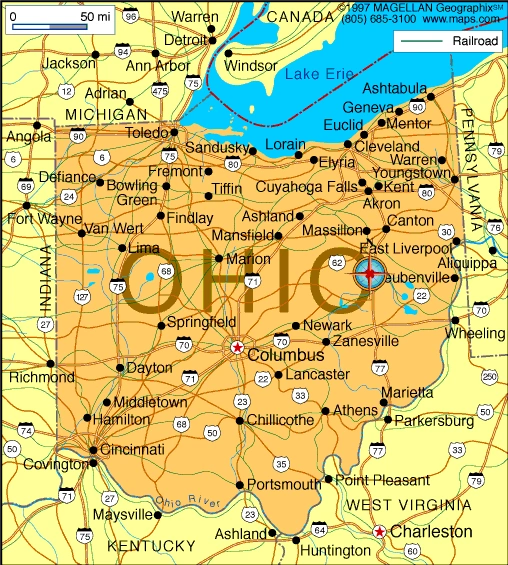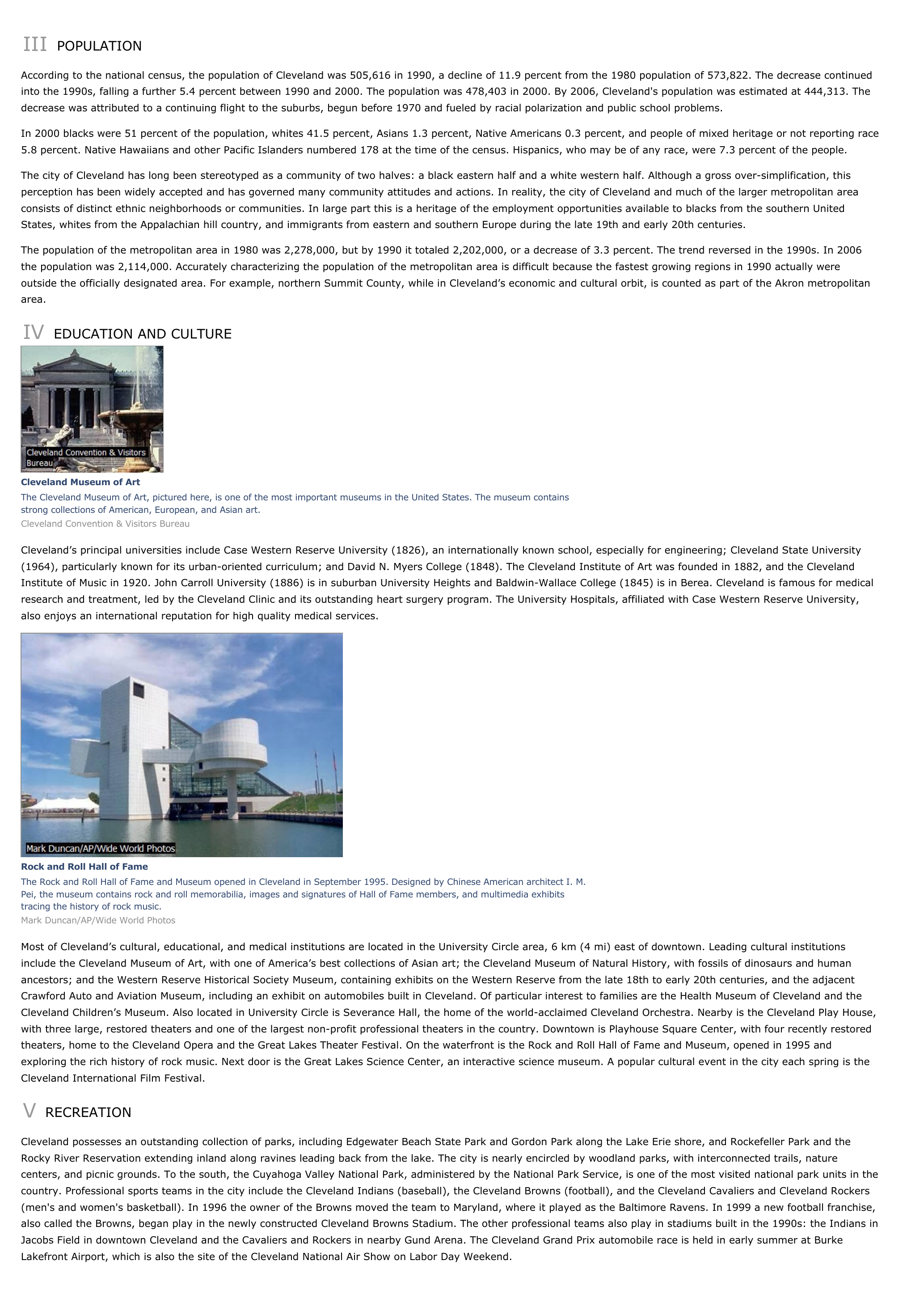Cleveland (Ohio) - geography.
Publié le 27/05/2013

Extrait du document


«
III POPULATION
According to the national census, the population of Cleveland was 505,616 in 1990, a decline of 11.9 percent from the 1980 population of 573,822.
The decrease continuedinto the 1990s, falling a further 5.4 percent between 1990 and 2000.
The population was 478,403 in 2000.
By 2006, Cleveland's population was estimated at 444,313.
Thedecrease was attributed to a continuing flight to the suburbs, begun before 1970 and fueled by racial polarization and public school problems.
In 2000 blacks were 51 percent of the population, whites 41.5 percent, Asians 1.3 percent, Native Americans 0.3 percent, and people of mixed heritage or not reporting race5.8 percent.
Native Hawaiians and other Pacific Islanders numbered 178 at the time of the census.
Hispanics, who may be of any race, were 7.3 percent of the people.
The city of Cleveland has long been stereotyped as a community of two halves: a black eastern half and a white western half.
Although a gross over-simplification, thisperception has been widely accepted and has governed many community attitudes and actions.
In reality, the city of Cleveland and much of the larger metropolitan areaconsists of distinct ethnic neighborhoods or communities.
In large part this is a heritage of the employment opportunities available to blacks from the southern UnitedStates, whites from the Appalachian hill country, and immigrants from eastern and southern Europe during the late 19th and early 20th centuries.
The population of the metropolitan area in 1980 was 2,278,000, but by 1990 it totaled 2,202,000, or a decrease of 3.3 percent.
The trend reversed in the 1990s.
In 2006the population was 2,114,000.
Accurately characterizing the population of the metropolitan area is difficult because the fastest growing regions in 1990 actually wereoutside the officially designated area.
For example, northern Summit County, while in Cleveland’s economic and cultural orbit, is counted as part of the Akron metropolitanarea.
IV EDUCATION AND CULTURE
Cleveland Museum of ArtThe Cleveland Museum of Art, pictured here, is one of the most important museums in the United States.
The museum containsstrong collections of American, European, and Asian art.Cleveland Convention & Visitors Bureau
Cleveland’s principal universities include Case Western Reserve University (1826), an internationally known school, especially for engineering; Cleveland State University(1964), particularly known for its urban-oriented curriculum; and David N.
Myers College (1848).
The Cleveland Institute of Art was founded in 1882, and the ClevelandInstitute of Music in 1920.
John Carroll University (1886) is in suburban University Heights and Baldwin-Wallace College (1845) is in Berea.
Cleveland is famous for medicalresearch and treatment, led by the Cleveland Clinic and its outstanding heart surgery program.
The University Hospitals, affiliated with Case Western Reserve University,also enjoys an international reputation for high quality medical services.
Rock and Roll Hall of FameThe Rock and Roll Hall of Fame and Museum opened in Cleveland in September 1995.
Designed by Chinese American architect I.
M.Pei, the museum contains rock and roll memorabilia, images and signatures of Hall of Fame members, and multimedia exhibitstracing the history of rock music.Mark Duncan/AP/Wide World Photos
Most of Cleveland’s cultural, educational, and medical institutions are located in the University Circle area, 6 km (4 mi) east of downtown.
Leading cultural institutionsinclude the Cleveland Museum of Art, with one of America’s best collections of Asian art; the Cleveland Museum of Natural History, with fossils of dinosaurs and humanancestors; and the Western Reserve Historical Society Museum, containing exhibits on the Western Reserve from the late 18th to early 20th centuries, and the adjacentCrawford Auto and Aviation Museum, including an exhibit on automobiles built in Cleveland.
Of particular interest to families are the Health Museum of Cleveland and theCleveland Children’s Museum.
Also located in University Circle is Severance Hall, the home of the world-acclaimed Cleveland Orchestra.
Nearby is the Cleveland Play House,with three large, restored theaters and one of the largest non-profit professional theaters in the country.
Downtown is Playhouse Square Center, with four recently restoredtheaters, home to the Cleveland Opera and the Great Lakes Theater Festival.
On the waterfront is the Rock and Roll Hall of Fame and Museum, opened in 1995 andexploring the rich history of rock music.
Next door is the Great Lakes Science Center, an interactive science museum.
A popular cultural event in the city each spring is theCleveland International Film Festival.
V RECREATION
Cleveland possesses an outstanding collection of parks, including Edgewater Beach State Park and Gordon Park along the Lake Erie shore, and Rockefeller Park and theRocky River Reservation extending inland along ravines leading back from the lake.
The city is nearly encircled by woodland parks, with interconnected trails, naturecenters, and picnic grounds.
To the south, the Cuyahoga Valley National Park, administered by the National Park Service, is one of the most visited national park units in thecountry.
Professional sports teams in the city include the Cleveland Indians (baseball), the Cleveland Browns (football), and the Cleveland Cavaliers and Cleveland Rockers(men's and women's basketball).
In 1996 the owner of the Browns moved the team to Maryland, where it played as the Baltimore Ravens.
In 1999 a new football franchise,also called the Browns, began play in the newly constructed Cleveland Browns Stadium.
The other professional teams also play in stadiums built in the 1990s: the Indians inJacobs Field in downtown Cleveland and the Cavaliers and Rockers in nearby Gund Arena.
The Cleveland Grand Prix automobile race is held in early summer at BurkeLakefront Airport, which is also the site of the Cleveland National Air Show on Labor Day Weekend..
»
↓↓↓ APERÇU DU DOCUMENT ↓↓↓
Liens utiles
- Cleveland (Ohio) - geography.
- Newman Paul, né en 1925 à Cleveland (Ohio), acteur et cinéaste américain.
- Cushing Harvey Williams , 1869-1939, né à Cleveland (Ohio), médecin américain.
- Ayler Albert , 1936-1970, né à Cleveland (Ohio), saxophoniste de jazz américain.
- Ohio - geography.

































